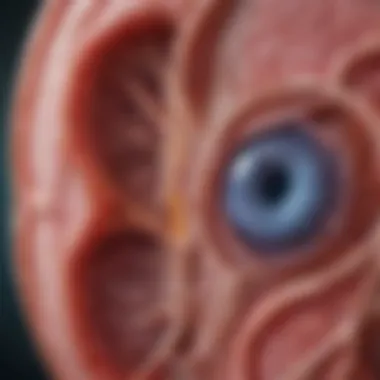Fibrocystic Kidney Disease: Insights on Causes and Care


Intro
Fibrocystic kidney disease is an important medical condition characterized by the presence of numerous cysts in the renal tissues. Patients suffering from this illness face various complications that can impact their quality of life and overall health. Understanding this disease requires a deep dive into its nature, symptoms, and management options. The implications of fibrocystic kidney disease extend beyond individual cases, influencing healthcare systems and necessitating informed approaches for diagnosis and treatment.
In this article, we aim to present a comprehensive guide that covers the essentials of fibrocystic kidney disease. We will discuss its causes, symptoms, available diagnostic tools, and the most effective management strategies. Highlighting the significance of early detection, we focus on how clinical awareness of this condition can lead to better patient outcomes.
Research Overview
Summary of Key Findings
Fibrocystic kidney disease is analyzed extensively in clinical studies. Recent research indicates that genetic mutations play a crucial role in its pathogenesis. Around 90% of cases are attributed to mutations in the PKD1 gene, while mutations in the PKD2 gene account for the remaining instances. Understanding these genetic underpinnings is essential for clinicians, as it informs not only diagnosis but also potential future therapies.
Background and Context
The disease manifests through the formation of fluid-filled cysts in kidney tissues, leading to progressive renal dysfunction. This has profound implications for patients, who may experience hypertension, kidney infection, and eventual renal failure. The consequences can require therapeutic intervention such as dialysis or kidney transplantation. Knowledge of the underlying mechanisms and patient presentation is vital for healthcare professionals.
"Early detection of fibrocystic kidney disease is critical for improving patient health outcomes."
Methodology
Experimental Design
A comprehensive literature review comprised of peer-reviewed articles, clinical guidelines, and meta-analyses provides the backbone of this research overview. Studies focusing on both genetic and symptomatic aspects of the disease were selected to draw a detailed understanding of the current landscape of fibrocystic kidney disease assessment and therapy.
Data Collection Techniques
Data collection was achieved through various databases such as PubMed and Cochrane Library. Researchers focused on recent studies to capture the latest trends and findings. Patient surveys and interviews from medical centers also offered invaluable insight into the lived experiences of those affected by the disease.
Prologue to Fibrocystic Kidney Disease
Fibrocystic kidney disease is a complex condition that affects countless individuals, making understanding this topic vital for both healthcare providers and patients. Importantly, it reflects underlying genetic and environmental factors leading to significant changes in renal function. Increasing awareness of this disease aids in early diagnosis and management. This can potentially improve the quality of life for affected individuals.
Definition and Overview
Fibrocystic kidney disease, also known as adult polycystic kidney disease (APKD), is characterized by the formation of numerous fluid-filled cysts within the kidneys. These cysts can vary in size and quantity, affecting kidney architecture and function. The disease often emerges without warning and progresses over time, leading to kidney impairment or failure in severe cases. Understanding this condition involves recognizing both its clinical significance and the biological mechanisms at play.
Cysts may develop in both kidneys, but they can also affect other organs. The disease may go unnoticed for years, emphasizing the need for routine monitoring in those at risk, particularly family members of affected individuals. Current estimates suggest that APKD affects approximately 1 in 400 to 1 in 1,000 individuals, highlighting its relevance in the healthcare landscape.
Historical Context and Discovery
The recognition of fibrocystic kidney disease dates back to the 19th century. Initial observations were made when pathologists noted cysts in the kidneys of individuals during autopsy examinations. However, it was not until the 20th century that the genetic basis of the disease became clearer.
In the 1980s, groundbreaking research uncovered links to specific genes, namely PKD1 and PKD2, which have important roles in cyst formation. These discoveries transformed the understanding of fibrocystic kidney disease from merely a pathological finding to a genetic condition with hereditary implications. Over the years, advancements in imaging technology have allowed for improved diagnosis and management strategies.
Early detection of fibrocystic kidney disease is crucial. Understanding its implications aids in timely intervention and management to maintain kidney health.
Epidemiology of Fibrocystic Kidney Disease
Understanding the epidemiology of fibrocystic kidney disease is crucial for both medical professionals and affected individuals. This subfield of study highlights how widespread the disease is and how different population segments may experience varied effects. Recognizing prevalence and demographic variations aids in crafting early detection strategies and tailoring management approaches, which can improve patient outcomes.
Prevalence and Incidence Rates
Fibrocystic kidney disease is not uniformly prevalent across the globe. Studies indicate that its occurrence can vary significantly based on geographic and genetic factors. In populations where the disease is more common, like those from certain ethnic backgrounds, it tends to manifest in younger individuals. Overall, the lifetime risk of developing this condition can reach as high as 1 in 5000 in some communities.
Estimates suggest that approximately 3% of all patients with chronic kidney disease may have fibrocystic kidney disease. Furthermore, incidence rates show noticeable increases in specific regions due to inherited genetic factors. As researchers continue to gather data, understanding these rates enables better resource allocation for healthcare providers and patients alike.
Demographic Variations
Demographics play a significant role in the manifestation and experience of fibrocystic kidney disease. Factors such as age, gender, and ethnicity influence how the disease presents itself.
- Age: Most patients are diagnosed in early adulthood, but symptoms can appear at any age. Earlier detection in younger individuals can lead to different long-term care requirements.
- Gender: Some studies indicate a different prevalence between men and women. Women may experience more severe symptoms than men, necessitating tailored treatment plans.
- Ethnic background: Genetic makeup of certain ethnic groups can predispose them to fibrocystic kidney disease, necessitating culturally competent care approaches for diverse populations. For instance, individuals from Central European background may demonstrate higher rates of this condition.
"Epidemiology provides critical information to tackle health disparities and improve patient outcomes in the context of fibrocystic kidney disease."
Continued research in this area is necessary to further refine our understanding and address the complexities of fibrocystic kidney disease in diverse populations.
Pathophysiology of Fibrocystic Kidney Disease


Understanding the pathophysiology of fibrocystic kidney disease is vital for grasping the complexities of this condition. It delves into the mechanisms that drive the formation of cysts in the kidneys, which consequently impact overall renal function. A detailed exploration of the genetics, cyst formation mechanisms, and the effects on kidney performance is essential not only to comprehend the disease but also to inform treatment approaches.
Genetic Basis of the Disease
The genetic underpinnings of fibrocystic kidney disease primarily involve mutations in specific genes. The most notable are the PKD1 and PKD2 genes, which are associated with autosomal dominant and autosomal recessive forms of the disease, respectively.
- PKD1 Mutations
- PKD2 Mutations
- These mutations are linked to the more severe form, leading to earlier onset and more rapid disease progression.
- These generally result in a milder presentation of kidney disease, often leading to slower progression and late onset.
Mutations in these genes disrupt cellular signaling pathways integral for kidney development and maintenance. Understanding these genetic factors is crucial for predictive genetic testing and counseling, guiding individuals about their risks and management options.
Cyst Formation Mechanisms
Cyst formation in fibrocystic kidney disease results from multiple cellular processes. The following elements contribute significantly to this phenomenon:
- Dysregulated Cell Proliferation
- Fluid Accumulation
- Obstructed Nephrons
- Renal epithelial cells undergo abnormal proliferation, leading to cyst formation due to increased fluid secretion and altered cell cycle regulation.
- Cysts fill with fluid, expanding and compromising surrounding tissues. This can lead to increased intratubular pressure, further exacerbating the cyst formation process.
- With cysts disrupting normal nephron architecture, the body’s ability to filter blood is impaired. This obstruction contributes significantly to kidney dysfunction over time.
Understanding these mechanisms not only sheds light on the progression of the disease but also identifies potential targets for therapeutic intervention.
Impact on Renal Function
The impact of fibrocystic kidney disease on renal function is profound and multifaceted. As cysts develop, several issues can arise:
- Decreased Nephrons
- Hypertension Development
- Progressive Kidney Failure
- As cysts grow, they displace nephrons, reducing the functional renal mass and impairing filtration capabilities.
- Kidney function decline often leads to hypertension, complicating the overall management of patients.
- Over time, many patients experience progressive renal failure, necessitating advanced treatments such as dialysis or kidney transplantation.
The pathophysiology of fibrocystic kidney disease illustrates the need for ongoing research into effective therapeutic options and highlights the importance of early detection and management strategies.
In summary, the pathophysiology of fibrocystic kidney disease involves intricate genetic factors, mechanisms of cyst formation, and significant impacts on renal function. Awareness of these elements is crucial for healthcare professionals in diagnosing and managing this complex condition.
Clinical Manifestations
The clinical manifestations of fibrocystic kidney disease are critical to understanding its overall impact on individuals affected by this condition. Recognizing and interpreting these signs and symptoms can aid in timely diagnosis, treatment, and management of the disease, which ultimately can improve patient outcomes. Fibrocystic kidney disease does not present uniformly across all patients, and variations exist based on the genetic and environmental backgrounds of individuals. This variability makes the study of clinical manifestations particularly significant in tailoring treatment protocols.
Common Symptoms and Signs
Patients with fibrocystic kidney disease often experience a range of symptoms that can vary in severity. Common symptoms include:
- Abdominal pain: Pain may be localized in the abdomen or flank area due to the increased size of cysts.
- Hematuria: Blood in the urine is a notable sign that may arise as cysts rupture or become inflamed, leading to bleeding.
- Recurrent urinary tract infections (UTIs): The presence of multiple cysts can predispose individuals to acute and chronic infections in the urinary tract.
- Hypertension: Increased blood pressure may develop as renal function progressively declines over time.
- Reduced kidney function: Patients might notice decreased urine output, reflecting impaired kidney function in advanced cases.
Recognizing these symptoms early can assist healthcare providers in making informed decisions on further diagnostic testing and management strategies.
Complications Associated with the Disease
The complications arising from fibrocystic kidney disease can significantly affect the quality of life and overall health of patients. Some key complications include:
- Progressive renal insufficiency: Over time, the presence of cysts can lead to gradual loss of kidney function, necessitating renal replacement therapies such as dialysis or transplantation.
- Cyst infection: Infected renal cysts can cause severe acute symptoms, including fever and worsening abdominal pain.
- Formation of kidney stones: Blockages due to cysts can impede normal urinary flow leading to the formation of calculi.
- Increased risk of hypertension: Chronic kidney diseases can contribute to persistent high blood pressure, increasing the risk of cardiovascular diseases.
Understanding the range of possible complications is essential for patients and healthcare providers to develop a proactive approach to management.
Mitigating the risks associated with these complications often involves a multidisciplinary approach that includes urologists, nephrologists, and general practitioners, ensuring the most comprehensive care.
Diagnosis of Fibrocystic Kidney Disease
Diagnosing fibrocystic kidney disease is a crucial step in understanding the disease's progression and implementing effective management strategies. Accurate diagnosis involves a multi-faceted approach that combines clinical evaluation, imaging techniques, and histopathological assessments. Each component plays a vital role in forming a complete picture of the disease, allowing healthcare professionals to tailor treatments to individual patient needs.


Clinical Evaluation and Patient History
A thorough clinical evaluation is the foundation for diagnosing fibrocystic kidney disease. Healthcare providers often begin by obtaining a comprehensive patient history, looking for any family history of kidney diseases. A family history may indicate a genetic predisposition, notably in autosomal dominant forms of the disease. During this evaluation, it is essential to document any symptoms the patient may be experiencing, such as flank pain, hematuria, or hypertension. These symptoms can provide valuable insights into the severity and complications of the disease.
Additionally, understanding the patient's overall health, including any comorbid conditions, can influence the diagnostic approach and subsequent management plan. Clinical evaluation emphasizes the initial groundwork necessary for accurate diagnosis, setting the stage for further testing.
Imaging Techniques
Imaging plays a critical role in confirming a diagnosis of fibrocystic kidney disease. Several imaging modalities can be utilized, each with distinct advantages.
Ultrasound
Ultrasound is often the first-line imaging technique for kidney assessment due to its non-invasive nature and accessibility. It allows for real-time visualization of renal structures and can easily detect the presence of cysts within the kidneys. This imaging modality is beneficial for several reasons:
- No radiation exposure: Ultrasound uses sound waves, making it safer for repeated use and for vulnerable populations, such as children or pregnant women.
- Cost-effective: This method is generally less expensive than other imaging techniques.
- Rapid results: Ultrasound provides quick assessments, aiding in prompt clinical decision-making.
However, its limitations include limited ability to characterize cysts accurately and the potential for operator-dependent variability. This can sometimes lead to misinterpretation of findings, particularly in complex cases.
CT Scans
A computed tomography (CT) scan offers a more detailed view of the kidney structure compared to ultrasound. This imaging technique can provide cross-sectional images that reveal small cysts and evaluate other complications associated with fibrocystic kidney disease. Key characteristics include:
- High-resolution images: CT scans can capture finer details in renal architecture.
- Ability to assess complications: These scans can identify complications such as renal stones or infections that might coexist with cyst formation.
Nonetheless, CT scans do involve exposure to ionizing radiation, which is a significant consideration in the overall management plan. Patients should be informed about the risks versus benefits when utilizing this imaging technique.
MRI
Magnetic resonance imaging (MRI) is advantageous in specific cases where soft-tissue contrast is critical. It is used less frequently than ultrasound and CT but provides unique benefits:
- Excellent soft tissue contrast: MRI can differentiate between solid and cystic lesions, aiding in establishing whether a cyst is simple or complex.
- No radiation: Similar to ultrasound, MRI does not use ionizing radiation, making it a safer option for many patients.
However, MRI is generally more expensive and requires longer scanning times, which may not always be feasible in acute settings. Despite these drawbacks, its ability to provide comprehensive imaging makes it a valuable diagnostic tool in complex cases of fibrocystic kidney disease.
Biopsy and Histopathology
While imaging plays a central role in diagnosis, biopsy and histopathological examination may be necessary in selected cases to confirm the diagnosis. A renal biopsy can help distinguish between fibrocystic kidney disease and other kidney disorders. This step can be crucial, particularly in atypical presentations or in younger patients with suspected genetic conditions. Histopathological analysis can provide insights into the underlying mechanisms of cyst formation and renal damage, adding nuanced understanding for tailored management.
In summary, diagnosing fibrocystic kidney disease involves a structured approach combining clinical history, imaging, and at times, biopsy. The integration of these diagnostic tools provides clarity and ensures that healthcare professionals can offer the most effective management strategies for patients.
Management and Treatment Options
Managing fibrocystic kidney disease involves a multifaceted approach aimed at alleviating symptoms, slowing disease progression, and maintaining renal function. Effective management is essential for enhancing the quality of life for patients and prolonging renal health. There are various strategies available which can be divided into conservative management, pharmacological treatments, and surgical interventions. Addressing these approaches systematically allows for tailored patient care and the implementation of effective treatment protocols.
Conservative Management Strategies
Monitoring and Follow-Up
Monitoring and follow-up play a central role in managing fibrocystic kidney disease. Regular assessments help to track disease progression and renal function. This strategy is vital for proactive intervention when symptoms worsen or complications arise. The key characteristic of monitoring is its capacity to detect subtle changes that may indicate deterioration in kidney health. This makes it a preferred choice in ongoing disease management.
The unique feature of regular check-ups is the emphasis on individualized care plans. Tailoring follow-up appointments based on a patient's specific condition can lead to more significant outcomes. However, this approach can be resource-intensive, requiring patients to engage actively with their healthcare team, which can sometimes be challenging.
Lifestyle Modifications
Lifestyle modifications are an essential component of managing fibrocystic kidney disease. Simple adjustments, such as dietary changes and hydration levels, can significantly impact overall health. A key trait of lifestyle changes is their focus on education and empowerment for the patients. This helps them understand their condition better and take charge of their health.
A unique aspect of lifestyle modifications is that they can be easily integrated into daily routines. Patients can make choices that benefit their health without significant disruptions to their lifestyles. However, individuals may find it difficult to consistently adhere to these recommendations due to personal habits or limitations in resources.
Pharmacological Treatments
Management of Symptoms
Management of symptoms is crucial in alleviating the discomfort associated with fibrocystic kidney disease. This might encompass the use of analgesics, antihypertensives, or medications aimed at managing severe discomfort or addressing complications. A prominent aspect of this treatment type is the immediate relief offerred to patients, enhancing their quality of life.
The unique feature of symptom management is its adaptability. Healthcare providers can adjust medications based on patient needs and response patterns. However, side effects from long-term medication use can sometimes complicate the treatment pathway, requiring careful monitoring and adjustments.
Targeted Therapies
Targeted therapies represent a more advanced pharmacological approach to managing fibrocystic kidney disease. These therapies aim to specifically address the underlying mechanisms of the disease rather than solely focusing on alleviating symptoms. The emphasis here is on personalized medicine, which has been growing in popularity.


The unique benefit of targeted therapy is its potential for increased effectiveness with fewer side effects compared to traditional medications. However, access to these therapies may be limited and may require specialized medical oversight, which can pose challenges for some patients.
Surgical Interventions
Cyst Drainage
Cyst drainage is a surgical procedure utilized to relieve abdominal pain and discomfort caused by large cysts. This intervention is often considered in cases where conservative management fails to provide adequate relief. The key characteristic of cyst drainage is its ability to offer immediate symptom relief, helping patients regain their quality of life.
The unique aspect of this procedure is that it can be performed minimally invasively, often leading to quicker recovery times. However, cyst recurrence can occur, leading to the need for further interventions, which can be frustrating for patients.
Nephrectomy
Nephrectomy, or the surgical removal of a kidney, is considered in severe cases of fibrocystic kidney disease, particularly when kidney function is compromised. The main characteristic of nephrectomy is its radical nature, aiming to eliminate the source of dysfunction completely. It is generally seen as a last resort.
The unique feature here lies in its potential to save the remaining kidney function. However, it carries significant risks, and patients must weigh potential benefits against possible complications, such as infection or loss of renal function altogether.
Prognosis and Outlook
Prognosis and outlook are fundamental aspects when discussing fibrocystic kidney disease. Understanding these elements allows healthcare providers and patients alike to have a clearer view of the disease trajectory. It includes the potential outcomes linked with the disease and the various influences on patient health in the long term. Additionally, this section highlights the significance of early detection and continuous management strategies, which can significantly affect overall health and quality of life.
Factors Influencing Prognosis
Prognosis in fibrocystic kidney disease heavily relies on several critical factors. These factors include:
- Genetic Variants: The specific mutations within the PKD1 or PKD2 genes are crucial. Mutations in PKD1 often lead to a more severe form of the disease compared to PKD2 mutations.
- Cyst Growth and Progression: The rate at which cysts develop can indicate how the disease will progress. Rapid cyst formation can lead to quicker declines in renal function.
- Age at Diagnosis: Younger patients typically show slower disease progression, while those diagnosed later may experience more pronounced effects on kidney function.
- Renal Function at Diagnosis: Baseline kidney function is a significant element; the lower the function at the time of diagnosis, the worse the prognosis may be.
Beyond these genetic and physiological aspects, the quality of clinical care received plays a vital role in determining outcomes. Ongoing evaluation by healthcare professionals, adherence to treatment protocols, and patient lifestyle can all modify these prognostic factors favorably.
Long-Term Management Considerations
Successfully managing fibrocystic kidney disease throughout a patient's life is essential for ensuring the best prognosis. Key considerations include:
- Regular Surveillance: Continuous monitoring of kidney function through blood tests and imaging can catch complications early.
- Dietary Modifications: A balanced diet low in sodium, protein, and phosphorus may help to alleviate kidney load and support overall health.
- Fluid Management: Ensuring adequate hydration is necessary, but fluid intake must be tailored to overall kidney function and any existing complications.
- Managing Comorbid Conditions: Conditions like high blood pressure and diabetes should be closely managed, as they can exacerbate kidney issues.
- Patient Education: Informing patients regarding their condition, potential complications, and the importance of adherence to treatment modalities is critical for optimal long-term outcomes.
"A proactive approach in managing fibrocystic kidney disease not only improves quality of life but can also prolong kidney function."
In summary, the prognosis of fibrocystic kidney disease is multifaceted and deeply influenced by a variety of factors. Ongoing research into genetic underpinnings and therapies continues to evolve, promising better patient outcomes. It is necessary for patients and healthcare professionals to work closely to navigate this complex landscape.
Research and Future Directions
Research and future directions in fibrocystic kidney disease (FKD) are crucial for advancing understanding and management of this complex condition. As the medical community continues to uncover the genetic and molecular mechanisms behind FKD, patients can benefit from more targeted therapies and personalized care. Research not only illuminates the pathophysiology of the disease but also aids in discovering novel treatment strategies. The ongoing investigation into FKD has significant implications for both clinicians and affected individuals, as it may lead to improved outcomes and quality of life.
Current Advances in Research
Recent studies have made remarkable strides in understanding the genetic underpinnings of fibrocystic kidney disease. Research has identified specific genetic mutations, such as those in the PKD1 and PKD2 genes, which play a pivotal role in cyst formation. Investigators are employing genome sequencing technologies to pinpoint additional genetic markers associated with FKD. These advances in genetics not only enable early diagnosis but also pave the way for gene therapy approaches that aim to correct the underlying defects.
Furthermore, ongoing clinical trials are exploring new pharmacological options that target the pathways involved in cyst development. For example, the potential of using therapies like sirolimus or tolvaptan to slow cyst growth has garnered attention. These agents are being studied for their ability to improve renal function and decrease the progression of the disease.
Potential Future Therapies
The horizon for fibrocystic kidney disease management is brightening with the potential of emerging therapies. As research progresses, future therapies may include
- Gene therapy: This approach aims to rectify the genetic mutations responsible for FKD, potentially stopping the disease before it progresses.
- Molecular therapeutics: Targeted therapies that specifically address molecular pathways involved in cystogenesis could become a cornerstone of FKD treatment.
- Stem cell therapy: Explore the use of stem cells to repair or regenerate damaged kidney tissue, offering a novel avenue for restoring renal function.
Future therapies may significantly alter the landscape of FKD management, transforming the approach towards a more proactive and therapeutic paradigm.
The integration of these innovative strategies into clinical practice will require careful evaluation and validation. Along with advancements in therapy, continued emphasis on patient education and comprehensive care models will be essential. By harnessing ongoing research and adapting to new findings, healthcare professionals can better support individuals with fibrocystic kidney disease, improving their prognosis and minimizing complications.
Culmination
Understanding fibrocystic kidney disease is crucial for multiple reasons. This condition, characterized by the formation of multiple cysts within the kidneys, poses significant health challenges. A well-rounded comprehension of the disease can empower both healthcare providers and patients in navigating its complexities effectively.
Summary of Key Points
In summarizing the key points of this article, several core aspects stand out:
- Definition: Fibrocystic kidney disease involves the development of cysts that can lead to renal impairment.
- Epidemiology: The prevalence varies among populations, which necessitates awareness in different demographics.
- Pathophysiology: Genetic factors play a substantial role in its development, warranting further investigation.
- Clinical Manifestations: Patients often exhibit diverse symptoms, highlighting the importance of thorough clinical assessment.
- Diagnosis and Management: Timely diagnosis using imaging and biopsy is vital for optimal management, which may include both conservative and surgical approaches.
The Importance of Awareness and Research
Awareness about fibrocystic kidney disease has significant implications. Increasing public and professional understanding can lead to earlier detection. This emphasizes the necessity for ongoing research to refine management strategies and potentially uncover innovative therapeutic avenues. The interplay between awareness initiatives and scientific inquiry is vital, feeding into a broader cycle of knowledge that benefits all stakeholders involved.
"Knowledge is the key to empowerment in the face of chronic conditions like fibrocystic kidney disease."
The integration of current advances in research can pave the way for new treatment modalities, which may enhance the quality of life for those affected by this disease. Overall, fostering a culture of awareness and inquiry surrounding fibrocystic kidney disease remains imperative.







